Research on the Localization Method of Outdoor Ground Vibration Signals Based on MEMS Accelerometers
Abstract
1. Introduction
2. Vibration Wave Propagation Model
3. Sensor Deployment Configuration
3.1. GDOP
3.2. Particle Swarm Optimization
3.3. Geometric Configuration Optimization Based on PSO
- (1)
- The GDOP value is calculated by taking the edge distance of 0.5–5 m, respectively, to determine the general range of the optimal geometric configuration.
- (2)
- Select the interval with small GDOP as the optimization range, and initialize parameters such as population size and iteration times. The coordinates of the four sensors are optimized output parameters. Where .
- (3)
- Select the fitness function. In order to find the geometric configuration with minimal GDOP, the GDOP value within the configuration range is taken as the fitness function.
- (4)
- The accuracy calculation is performed and the position of the solution is updated according to the weight allocation strategy.
- (5)
- Update and record the location of the solution.
- (6)
- Based on the current minimum GDOP value, the fitness is updated and the location of the optimal solution is determined.
- (7)
- By repeating steps (4) to (6), when the maximum number of iterations is reached, the position of the optimal solution is output, and the best combination of X and Y under the current data conditions is determined.
4. Delay Estimation Algorithm
4.1. Traditional Time Delay Estimation Algorithm
4.1.1. Cross Correlation
4.1.2. STA/LTA
4.2. SWD–STA/LTA–AIC
4.2.1. AIC
4.2.2. Sliding Window Derivative
5. Implementation of TDOA Localization Algorithm
5.1. Traditional Localization Algorithm
5.1.1. Direct Solution Method
5.1.2. Taylor Series Expansion Method
5.1.3. Chan Algorithm
5.2. Improved Two-Step Weighted Least Squares Method
5.3. Ground Vibration Signal Localization Based on SWD-STA/LTA-AIC-ITWLS
6. Experiment and Result Analysis
6.1. Configuration Determination of Sensors
6.2. Vibration Signal Localization
6.2.1. On-Site Test Scenario
6.2.2. Localization Calculation
6.2.3. Evaluation Indicators
7. Conclusions
Author Contributions
Funding
Institutional Review Board Statement
Informed Consent Statement
Data Availability Statement
Conflicts of Interest
References
- Felemban, E. Advanced border intrusion detection and surveillance using wireless sensor network technology. Int. J. Commun. Netw. Syst. Sci. 2013, 6, 251–259. [Google Scholar] [CrossRef]
- Akkaya, K.; Younis, M.; Youssef, W. Positioning of base stations in wireless sensor networks. IEEE Commun. Mag. 2007, 45, 96–102. [Google Scholar] [CrossRef]
- Butun, I.; Morgera, S.D.; Sankar, R. A survey of intrusion detection systems in wireless sensor networks. IEEE Commun. Surv. Tutor. 2013, 16, 266–282. [Google Scholar] [CrossRef]
- Shit, R.C.; Sharma, S.; Puthal, D.; James, P.; Pradhan, B.; van Moorsel, A.; Zomaya, A.Y.; Ranjan, R. Ubiquitous localization (UbiLoc): A survey and taxonomy on device free localization for smart world. IEEE Commun. Surv. Tutor. 2019, 21, 3532–3564. [Google Scholar]
- Shastri, A.; Valecha, N.; Bashirov, E.; Tataria, H.; Lentmaier, M.; Tufvesson, F.; Rossi, M.; Casari, P. A review of millimeter wave device-based localization and device-free sensing technologies and applications. IEEE Commun. Surv. Tutor. 2022, 24, 1708–1749. [Google Scholar]
- Zekavat, S.; Buehrer, R.M.; Durgin, G.D.; Lovisolo, L.; Wang, Z.; Goh, S.T.; Ghasemi, A. An overview on position location: Past, present, future. Int. J. Wirel. Inf. Netw. 2021, 28, 45–76. [Google Scholar]
- Zhu, C.; Sheng, W. Wearable sensor-based hand gesture and daily activity recognition for robot-assisted living. IEEE Trans. Syst. Man Cybern.-Part A Syst. Hum. 2011, 41, 569–573. [Google Scholar] [CrossRef]
- Sun, B.; Osborne, L.; Xiao, Y.; Guizani, S. Intrusion detection techniques in mobile ad hoc and wireless sensor networks. IEEE Wirel. Commun. 2007, 14, 56–63. [Google Scholar] [CrossRef]
- Sharp, I.; Yu, K.; Guo, Y.J. GDOP analysis for positioning system design. IEEE Trans. Veh. Technol. 2009, 58, 3371–3382. [Google Scholar] [CrossRef]
- Casanova, D.; Avendaño, M.; Mortari, D. Seeking GDOP-optimal Flower Constellations for global coverage problems through evolutionary algorithms. Aerosp. Sci. Technol. 2014, 39, 331–337. [Google Scholar] [CrossRef]
- Miao, S.; Dong, L.; Hou, J. Dynamic base stations selection method for passive location based on GDOP. PLoS ONE 2022, 17, e0272487. [Google Scholar] [CrossRef] [PubMed]
- Tahat, A.; Kaddoum, G.; Yousefi, S.; Valaee, S.; Gagnon, F. A look at the recent wireless positioning techniques with a focus on algorithms for moving receivers. IEEE Access 2016, 4, 6652–6680. [Google Scholar] [CrossRef]
- Patwari, N.; Ash, J.N.; Kyperountas, S.; Hero, A.; Moses, R.; Correal, N. Locating the nodes: Cooperative localization in wireless sensor networks. IEEE Signal Process. Mag. 2005, 22, 54–69. [Google Scholar] [CrossRef]
- Shi, H.; Zhang, H.; Wang, X. A TDOA technique with super-resolution based on the volume cross-correlation function. IEEE Trans. Signal Process. 2016, 64, 5682–5695. [Google Scholar] [CrossRef]
- Lellouch, L.; Haupert, S.; Sueur, J. Sound source localization in a natural soundscape with autonomous recorder units based on a new time-difference-of-arrival algorithm. Appl. Acoust. 2025, 235, 110648. [Google Scholar] [CrossRef]
- Li, J.; Li, Y.; Jiang, H.; Zhang, X.; Wu, Q. Multi-TDOA estimation and source direct position determination based on parallel factor analysis. IEEE Internet Things J. 2022, 10, 7405–7415. [Google Scholar] [CrossRef]
- Zhu, N.; Reza, T. A modified cross-correlation algorithm to achieve the time difference of arrival in sound source localization. Meas. Control. 2019, 52, 212–221. [Google Scholar] [CrossRef]
- Heider, S.; Jetschny, S.; Bohlen, T. Towards an automatic seismic localization of human footsteps. Near Surf. Geophys. 2013, 11, 317–324. [Google Scholar] [CrossRef]
- Choudhary, P.; Goel, N.; Saini, M. Event detection and localization for sparsely populated outdoor environment using seismic sensor. In Proceedings of the 2020 IEEE Sixth International Conference on Multimedia Big Data (BigMM), New Delhi, India, 24–26 September 2020; pp. 346–350. [Google Scholar]
- Choudhary, P.; Goel, N.; Saini, M. A fingerprinting based audio-seismic systems for human target localization in an outdoor environment using regression. IEEE Sens. J. 2022, 22, 7944–7960. [Google Scholar] [CrossRef]
- Drira, S.; Pai, S.G.S.; Smith, I.F.C. Increasing occupant localization precision through identification of footstep-contact dynamics. Adv. Eng. Inform. 2021, 50, 101367. [Google Scholar] [CrossRef]
- Chiasson, D.; Lin, Y.; Kok, M.; Shull, P.B. Asynchronous hyperbolic UWB source-localization and self-localization for indoor tracking and navigation. IEEE Internet Things J. 2023, 10, 11655–11668. [Google Scholar] [CrossRef]
- Lakshmi, Y.V.; Singh, P.; Abouhawwash, M.; Mahajan, S.; Pandit, A.K.; Ahmed, A.B. Improved Chan algorithm based optimum UWB sensor node localization using hybrid particle swarm optimization. IEEE Access 2022, 10, 32546–32565. [Google Scholar] [CrossRef]
- Kim, D.S.; Lee, J.S. Propagation and attenuation characteristics of various ground vibrations. Soil Dyn. Earthq. Eng. 2000, 19, 115–126. [Google Scholar] [CrossRef]
- Ren, X.; Wu, J.; Tang, Y.; Yang, J. Propagation and attenuation characteristics of the vibration in soft soil foundations induced by high-speed trains. Soil Dyn. Earthq. Eng. 2019, 117, 374–383. [Google Scholar] [CrossRef]
- Tian, X.; Song, Z.; Wang, J. Study on the propagation law of tunnel blasting vibration in stratum and blasting vibration reduction technology. Soil Dyn. Earthq. Eng. 2019, 126, 105813. [Google Scholar] [CrossRef]
- Deng, Z.; Meng, J.; Deng, Y.; Ni, J.; Ye, D. Analysis of vibration signals near ground surface during blasting excavation of a tunnel in fractured rock. Sci. Rep. 2024, 14, 21909. [Google Scholar] [CrossRef] [PubMed]
- Huang, D.; Cui, S.; Li, X. Wavelet packet analysis of blasting vibration signal of mountain tunnel. Soil Dyn. Earthq. Eng. 2019, 117, 72–80. [Google Scholar] [CrossRef]
- Zhang, S.; Qin, L.; Li, X.; Kube, C.M. Propagation of Rayleigh waves on curved surfaces. Wave Motion 2020, 94, 102517. [Google Scholar] [CrossRef]
- Kennedy, J.; Eberhart, R. Particle swarm optimization. In Proceedings of the ICNN’95-International Conference on Neural Networks, Perth, WA, Australia, 27 November–1 December 1995; Volume 4, pp. 1942–1948. [Google Scholar]
- Chen, Z.; Liu, H.; Zhao, J.; Bi, T. Real-time event detection based on STA/LTA method using field synchrophasor measurements. IEEE Trans. Power Deliv. 2023, 38, 4070–4080. [Google Scholar] [CrossRef]
- Chan, Y.T.; Ho, K.C. A simple and efficient estimator for hyperbolic location. IEEE Trans. Signal Process. 1994, 42, 1905–1915. [Google Scholar] [CrossRef]
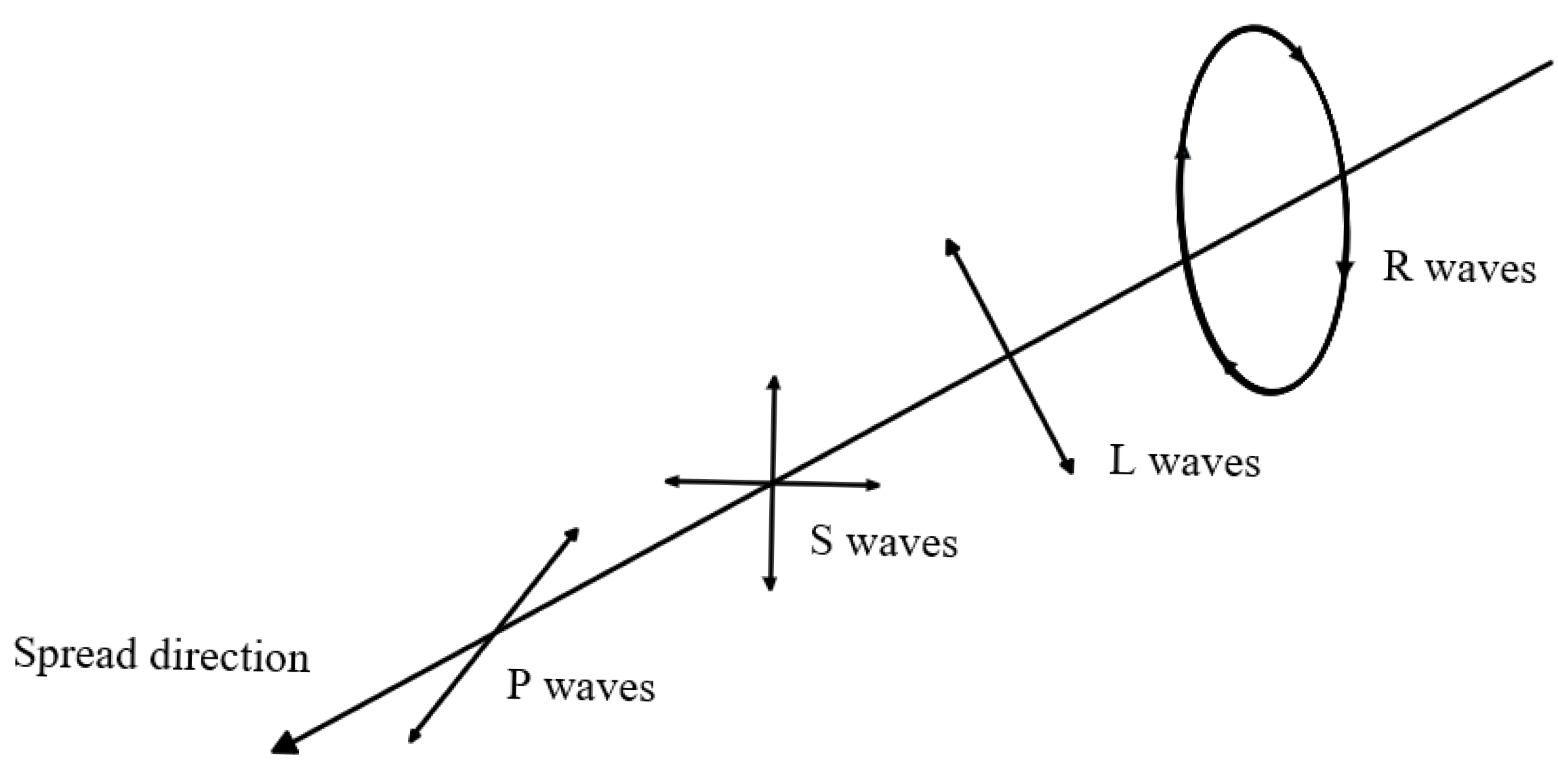
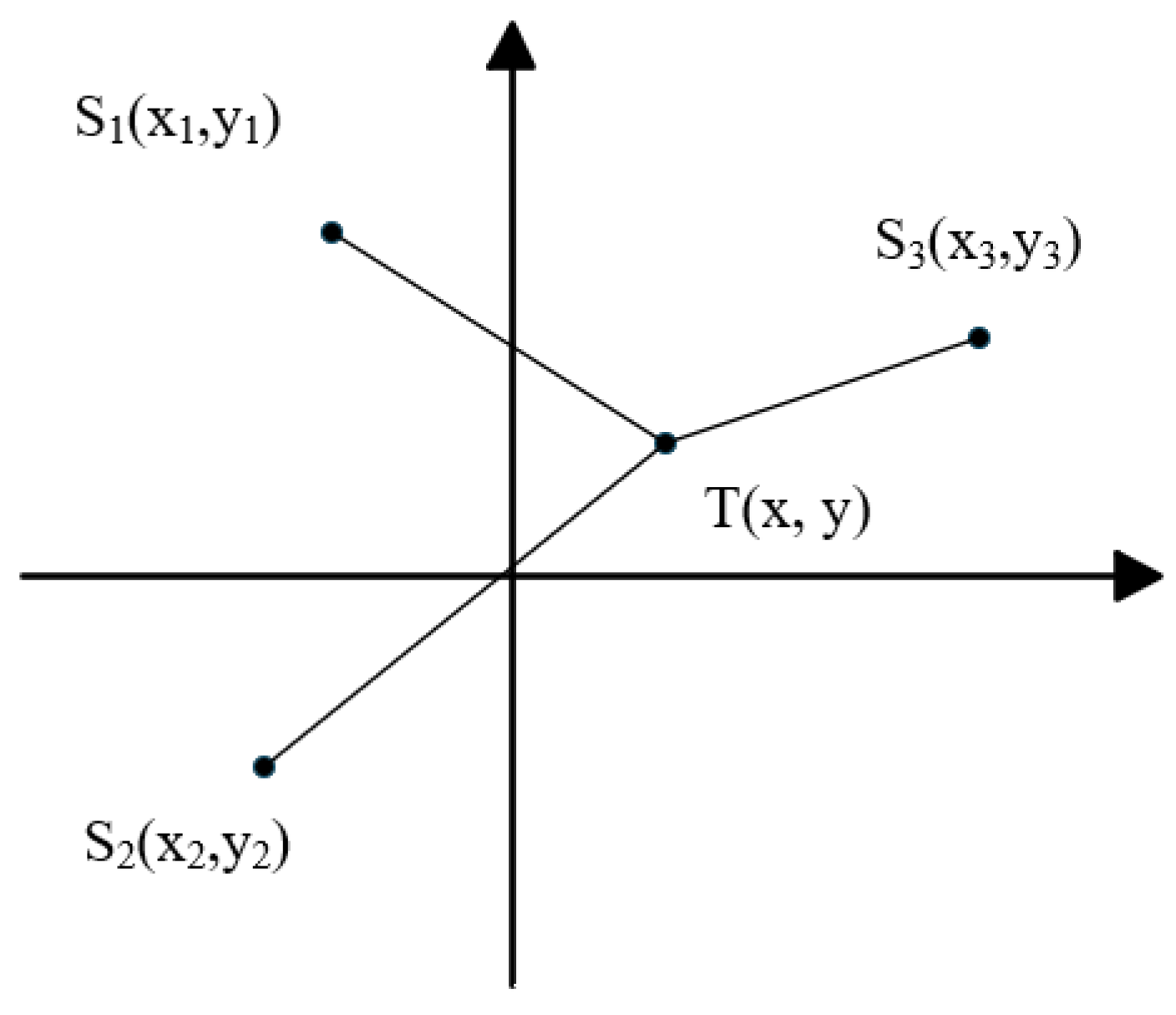
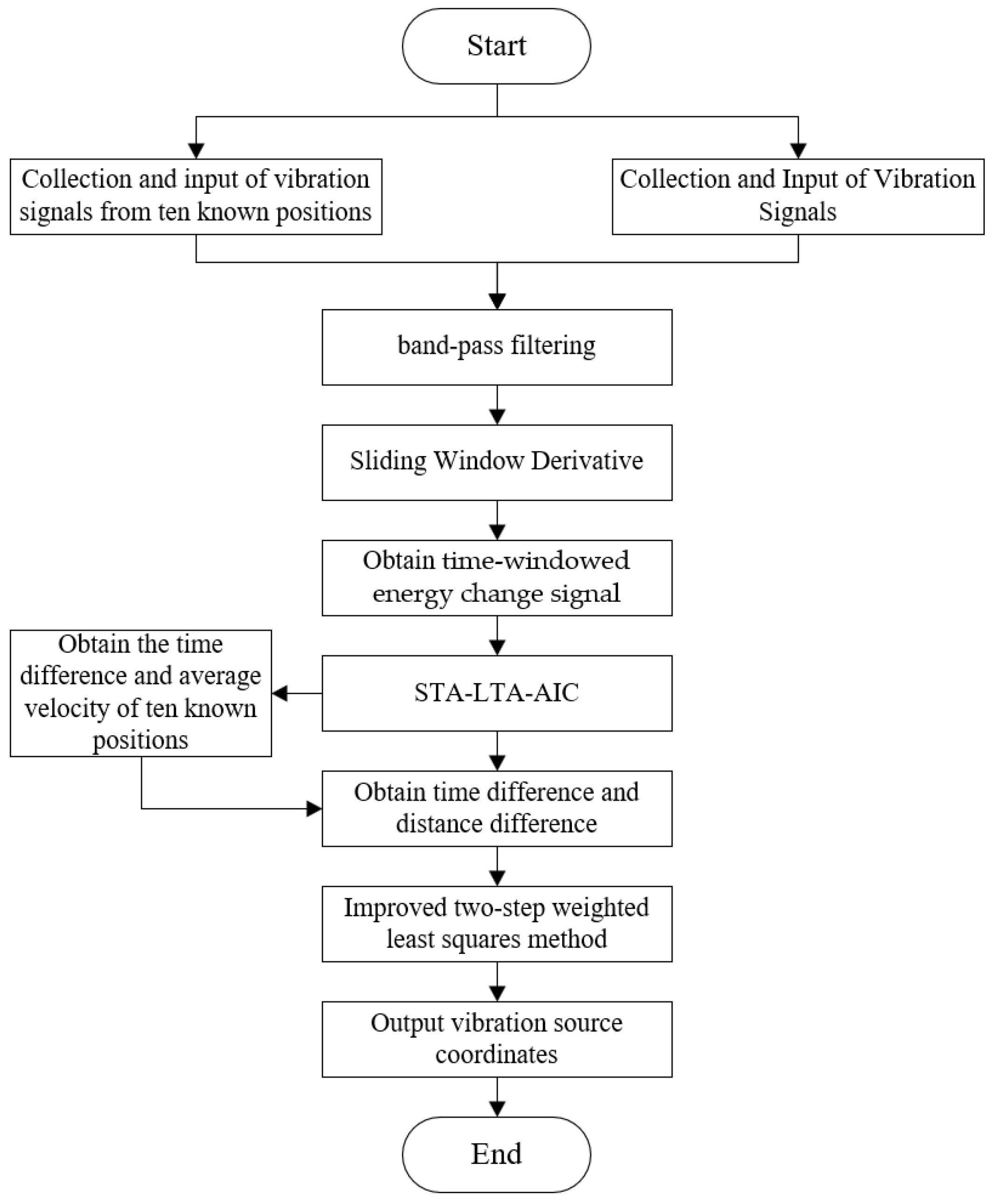

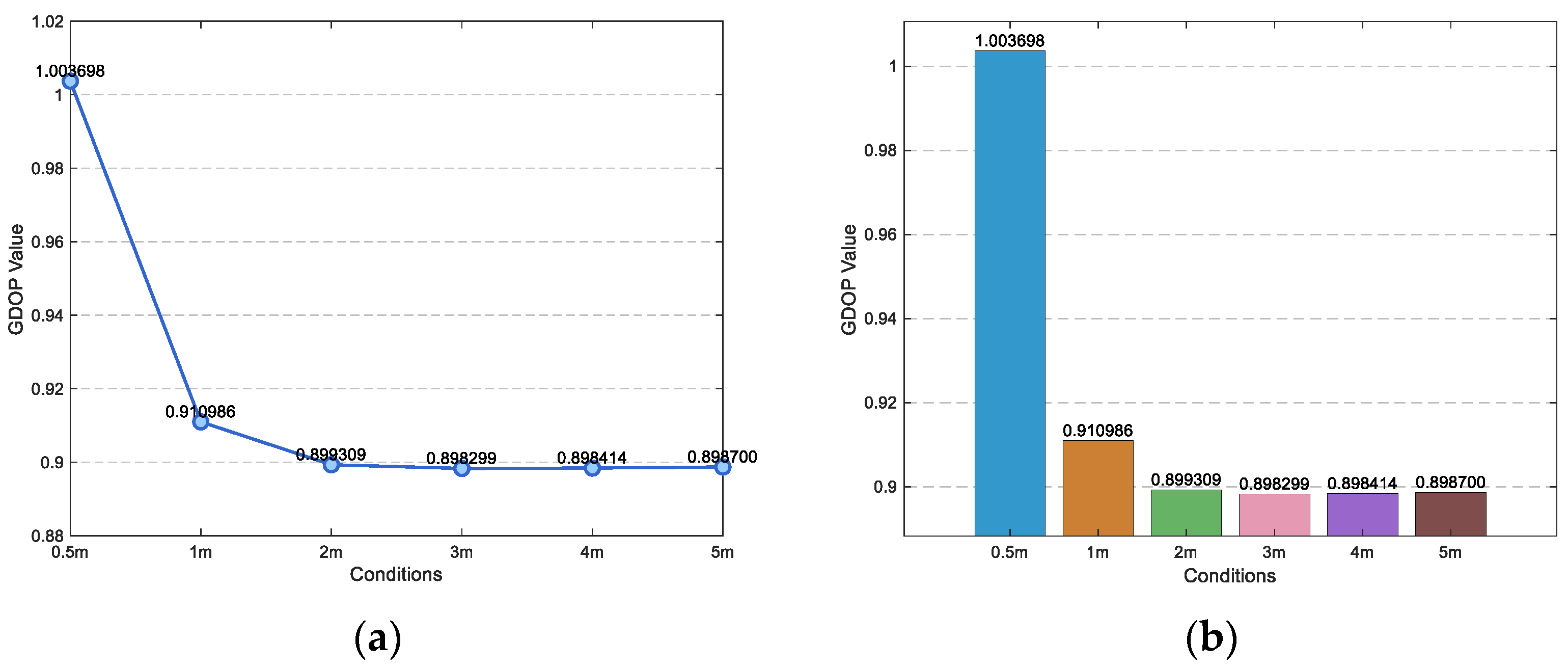
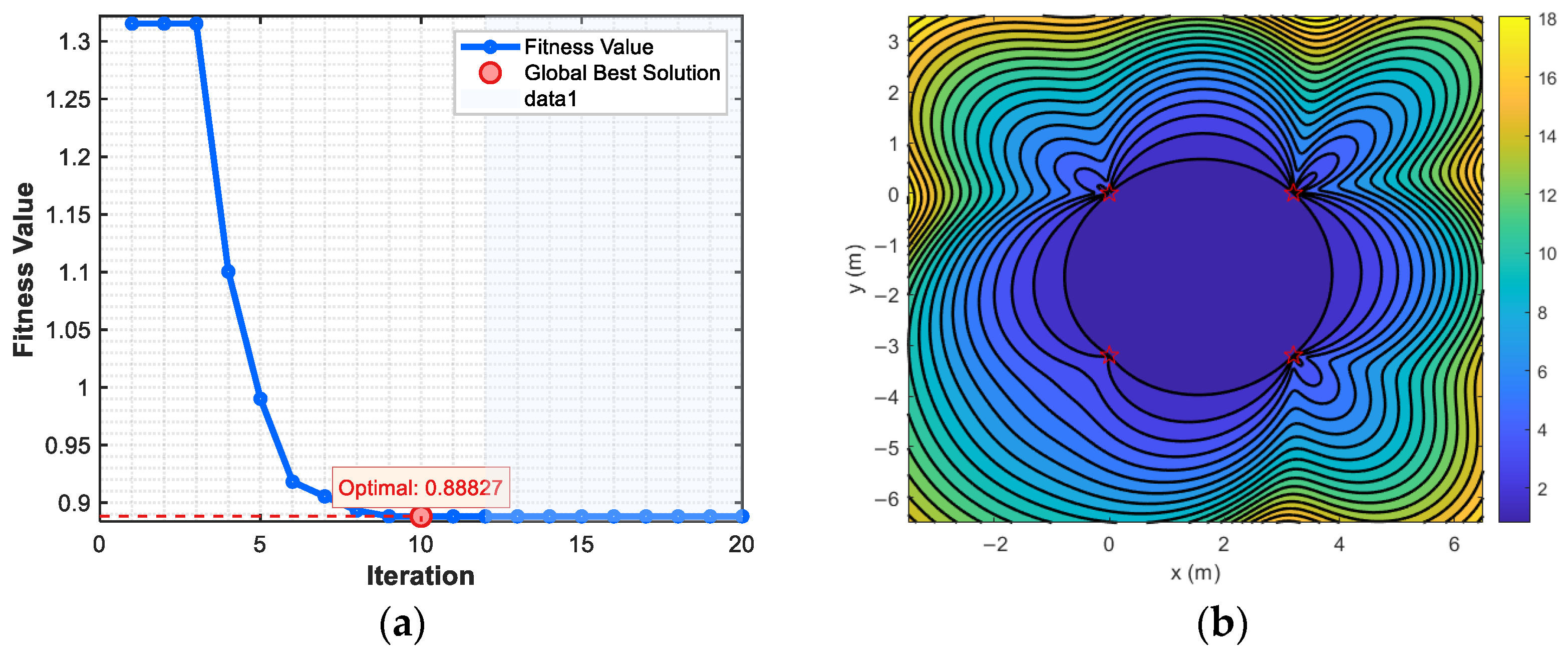
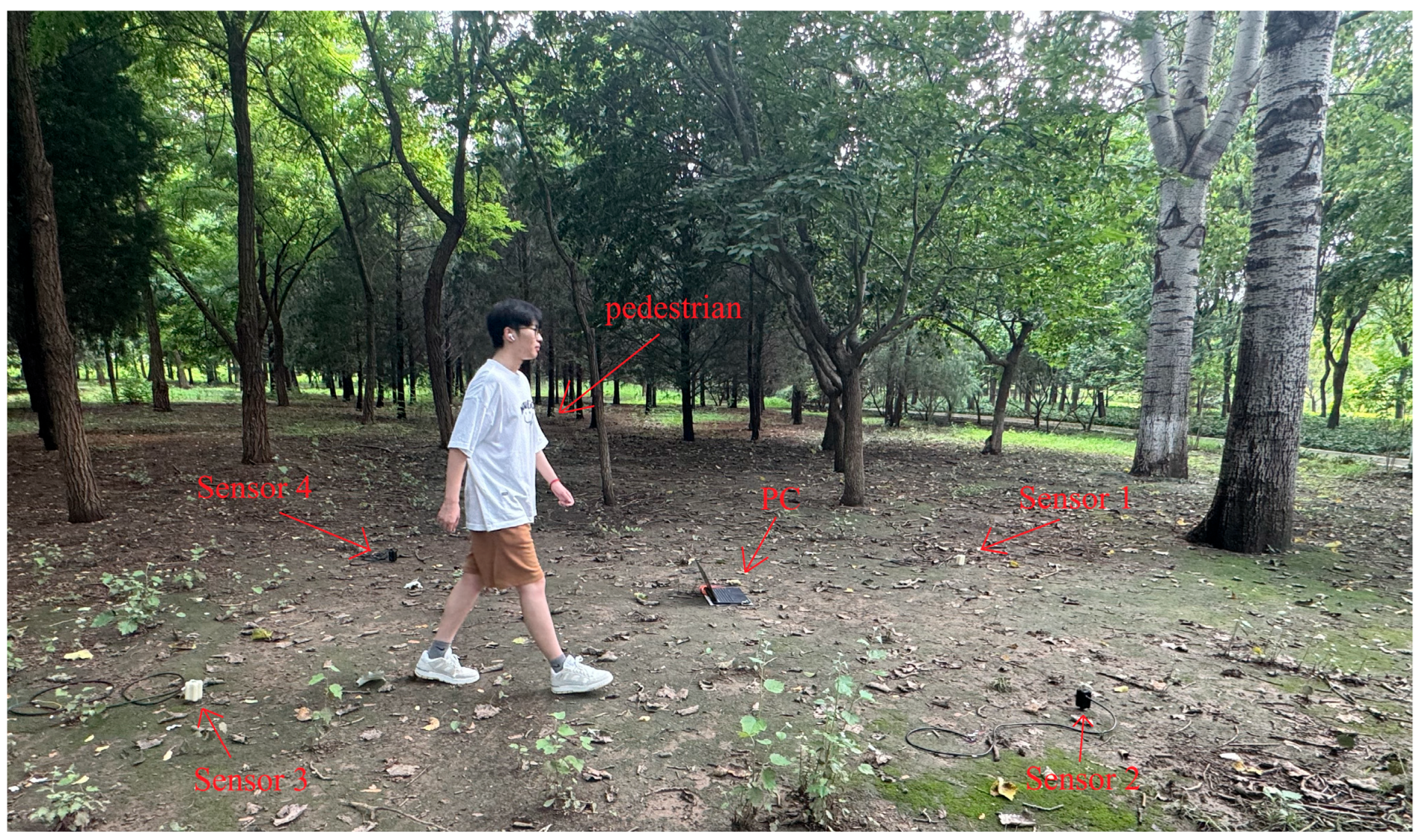
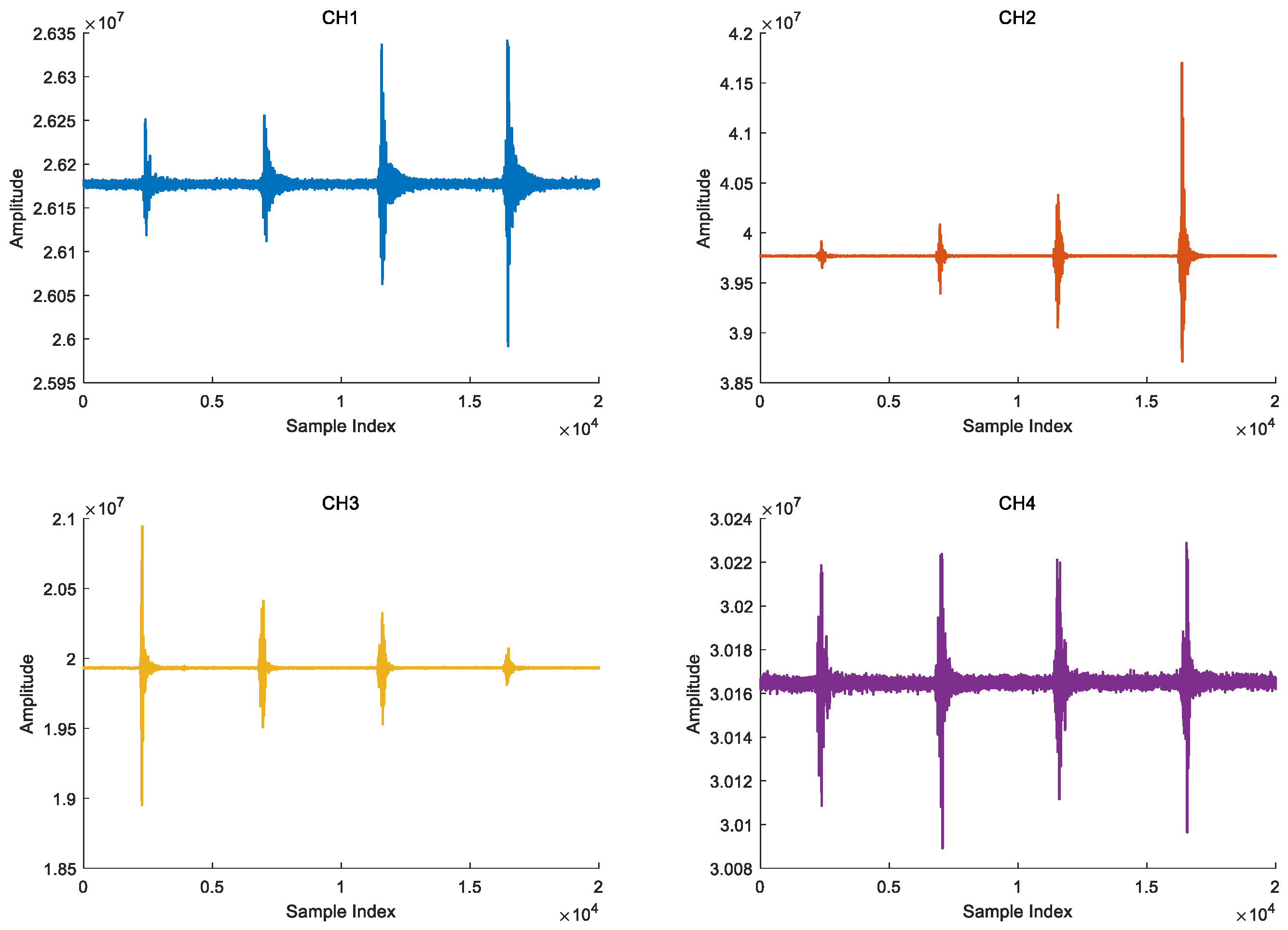
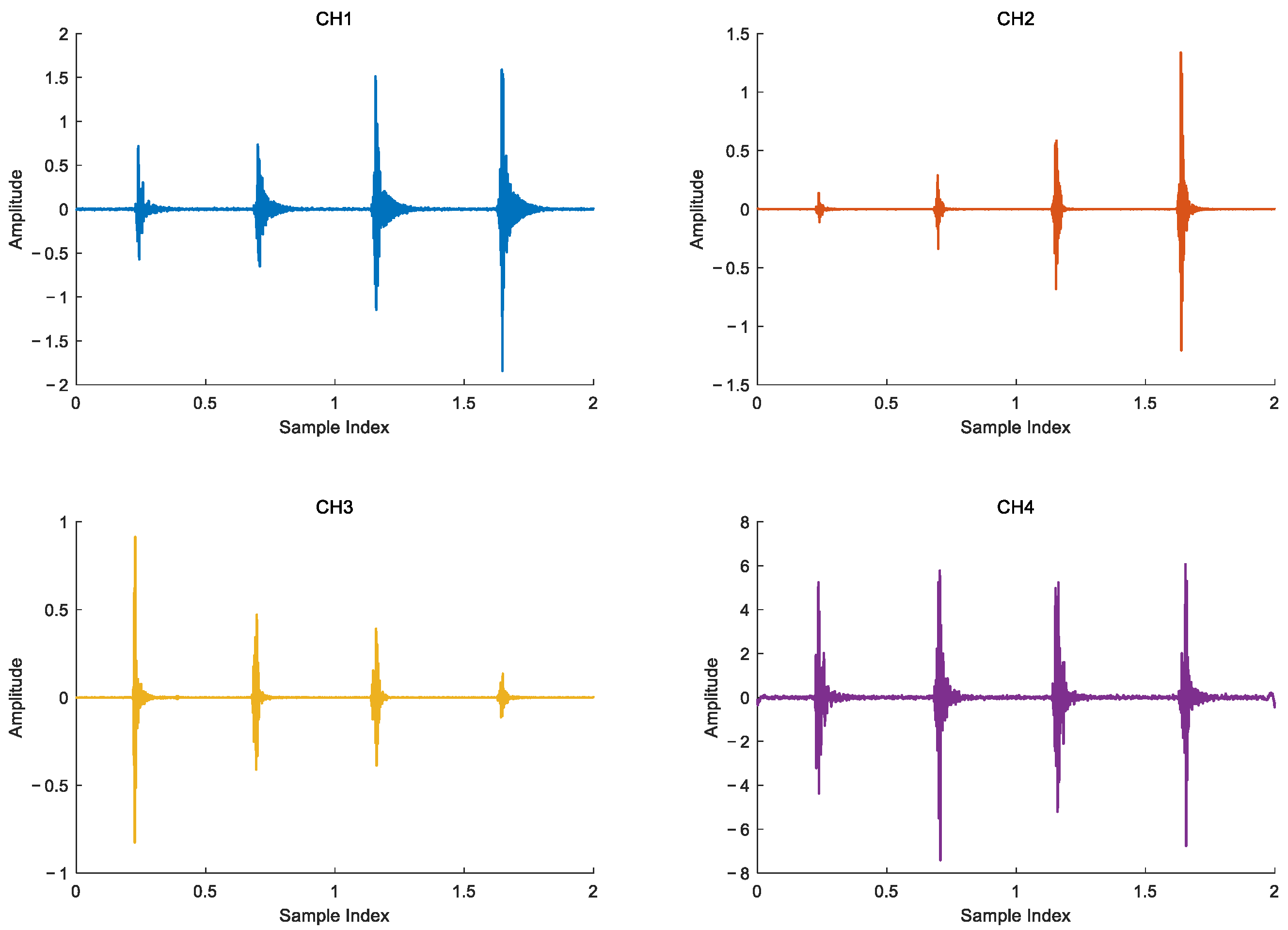
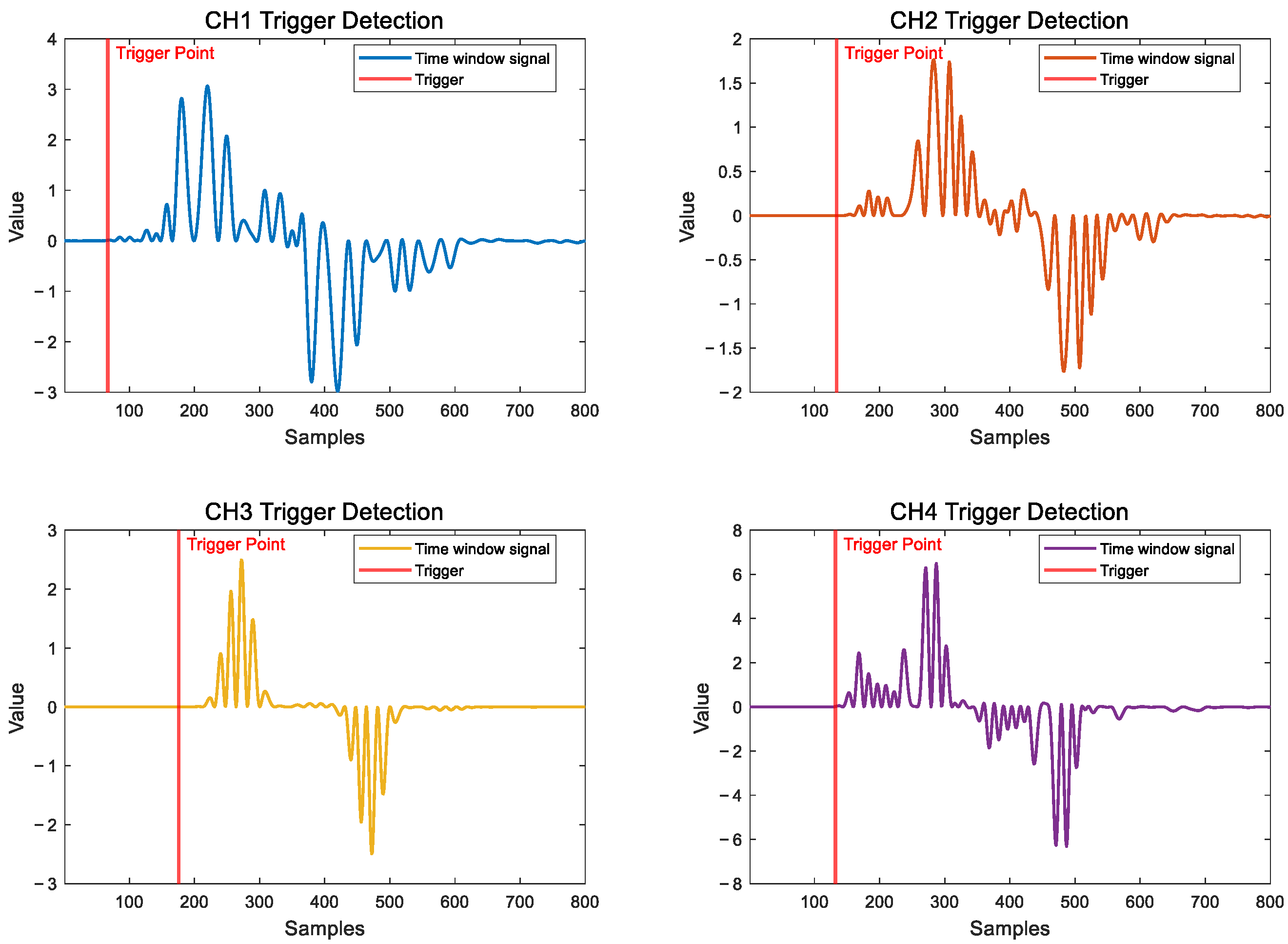
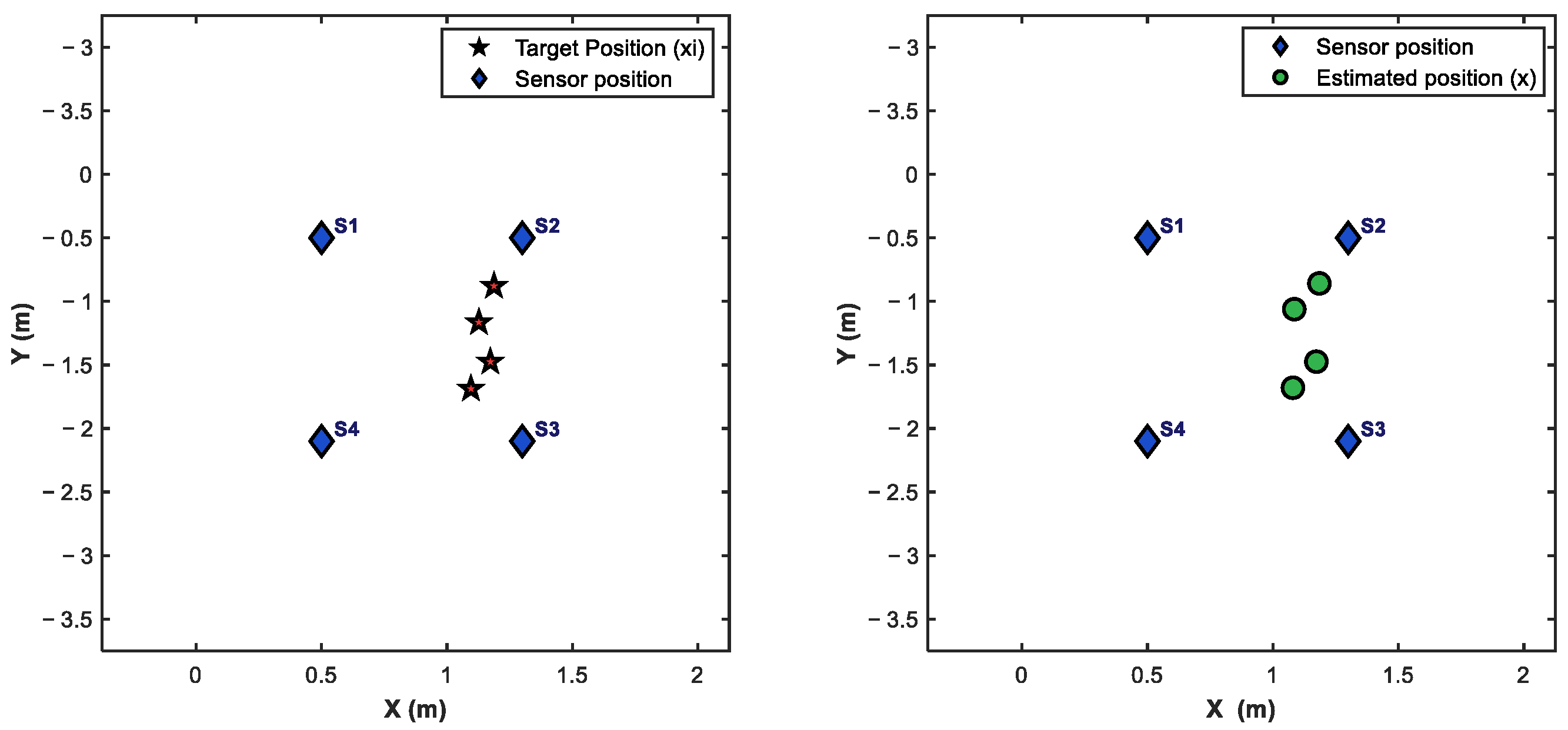
| Vibration Source | R12 (m) | R13 (m) | R14 (m) |
|---|---|---|---|
| Step 1 | −0.9108 | −2.5116 | −0.9660 |
| Step 2 | −0.9520 | −4.9280 | −0.3920 |
| Step 3 | −1.1524 | −0.6700 | −5.7352 |
| Step 4 | −4.8160 | 0.3360 | 0.9520 |
| Vibration Source | X (m) | Y (m) |
|---|---|---|
| Step 1 | 2.318960 | 2.318960 |
| Step 2 | 2.692348 | 2.692348 |
| Step 3 | 2.340707 | 2.340707 |
| Step 4 | 2.740262 | 2.740262 |
| Vibration Source | X (m) | Y (m) |
|---|---|---|
| Step 1 | 2.381513 | −2.375776 |
| Step 2 | 2.690587 | −1.951677 |
| Step 3 | 2.508005 | −1.330674 |
| Step 4 | 2.748957 | −0.758589 |
| Localization Algorithm | Average Position Error (m) | Average Direction Error (Degree) |
|---|---|---|
| CC-ITWLS | 4.214 | 49.49 |
| STA/LTA–ITWLS | 0.732 | 9.827 |
| SWD–STA/LTA–AIC–ITWLS | 0.095 | 0.935 |
Disclaimer/Publisher’s Note: The statements, opinions and data contained in all publications are solely those of the individual author(s) and contributor(s) and not of MDPI and/or the editor(s). MDPI and/or the editor(s) disclaim responsibility for any injury to people or property resulting from any ideas, methods, instructions or products referred to in the content. |
© 2025 by the authors. Licensee MDPI, Basel, Switzerland. This article is an open access article distributed under the terms and conditions of the Creative Commons Attribution (CC BY) license (https://creativecommons.org/licenses/by/4.0/).
Share and Cite
Liu, R.; Zhao, X.; Zhou, B.; Wei, Q. Research on the Localization Method of Outdoor Ground Vibration Signals Based on MEMS Accelerometers. Sensors 2025, 25, 5776. https://doi.org/10.3390/s25185776
Liu R, Zhao X, Zhou B, Wei Q. Research on the Localization Method of Outdoor Ground Vibration Signals Based on MEMS Accelerometers. Sensors. 2025; 25(18):5776. https://doi.org/10.3390/s25185776
Chicago/Turabian StyleLiu, Runping, Xiuyan Zhao, Bin Zhou, and Qi Wei. 2025. "Research on the Localization Method of Outdoor Ground Vibration Signals Based on MEMS Accelerometers" Sensors 25, no. 18: 5776. https://doi.org/10.3390/s25185776
APA StyleLiu, R., Zhao, X., Zhou, B., & Wei, Q. (2025). Research on the Localization Method of Outdoor Ground Vibration Signals Based on MEMS Accelerometers. Sensors, 25(18), 5776. https://doi.org/10.3390/s25185776







